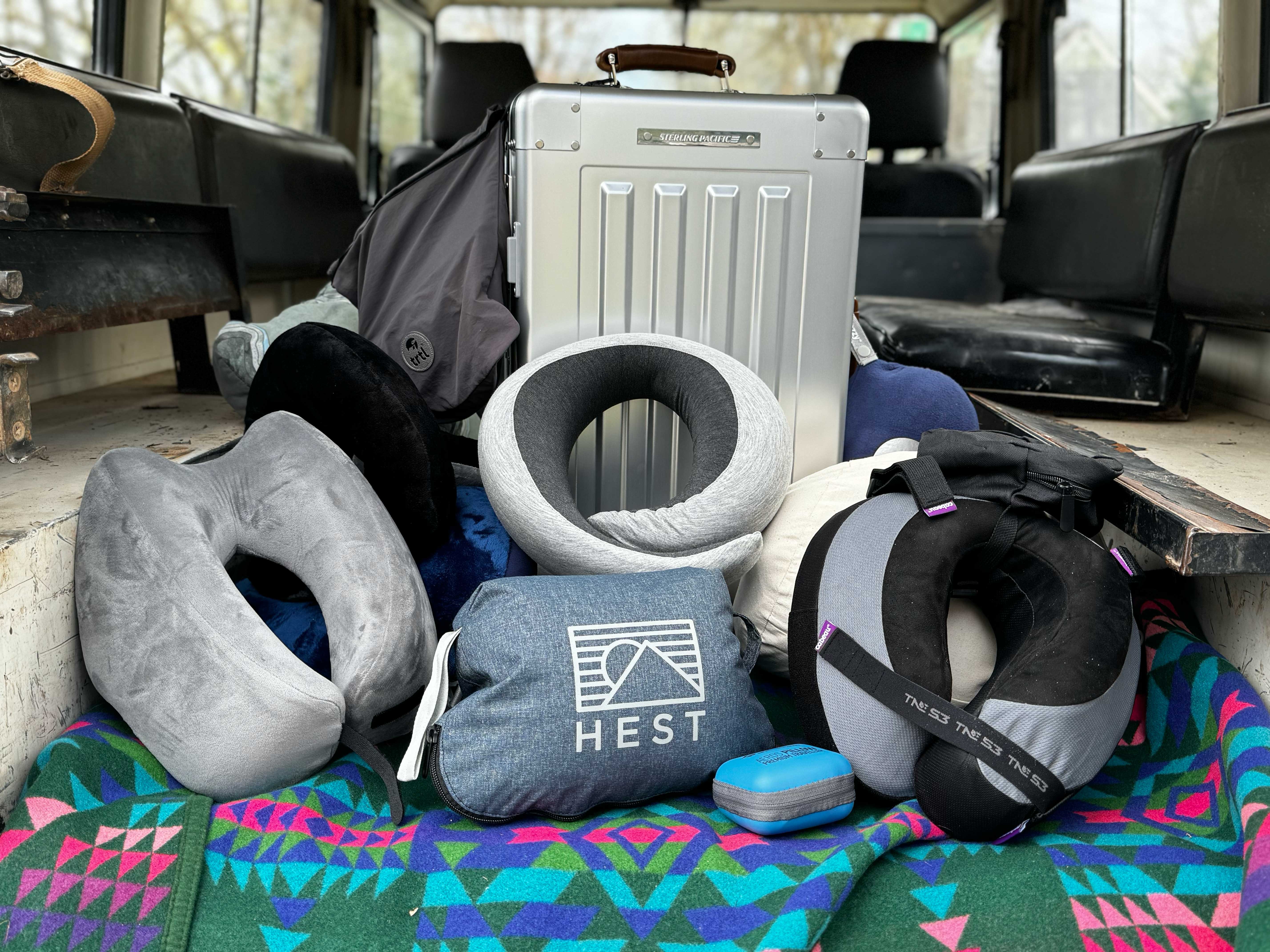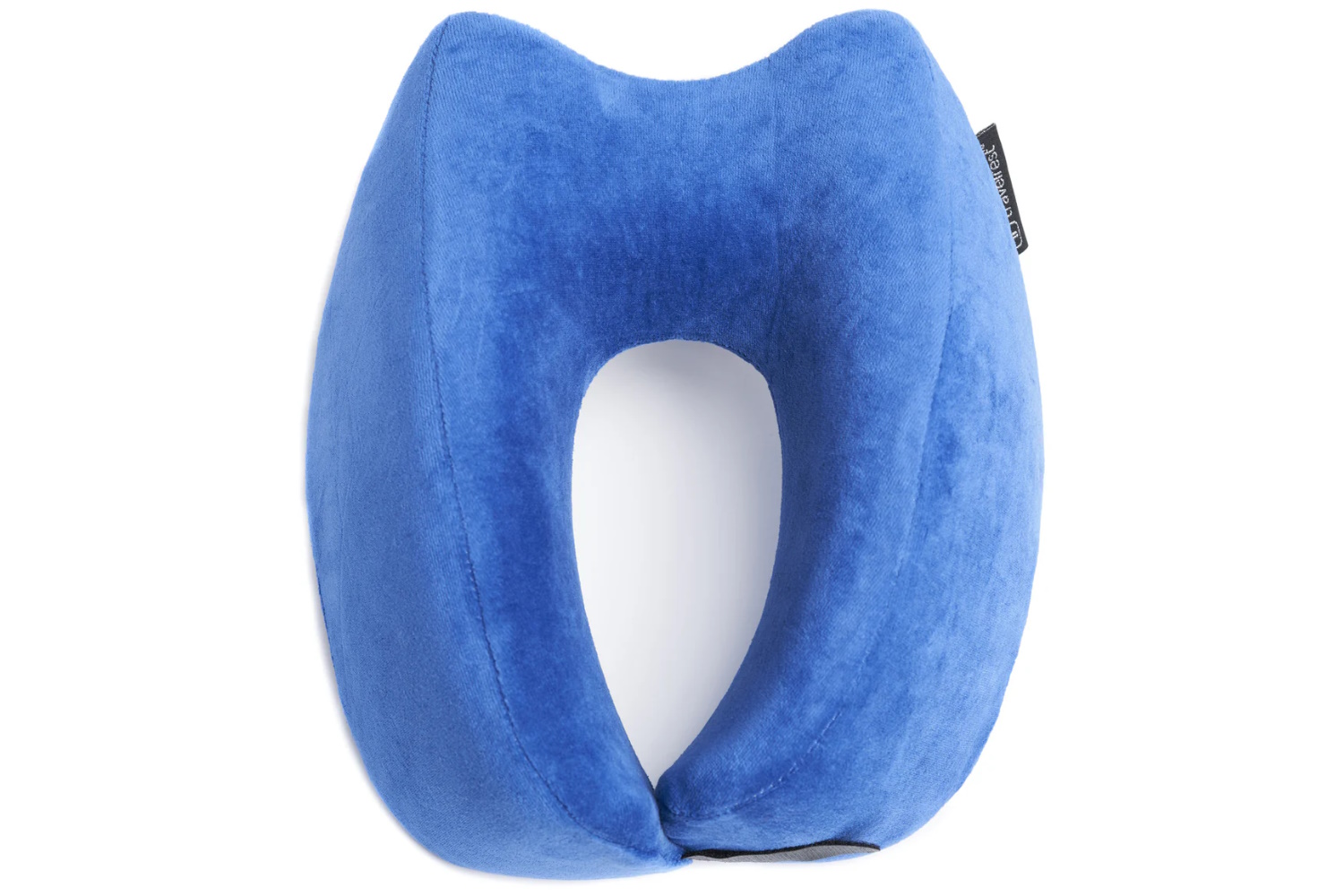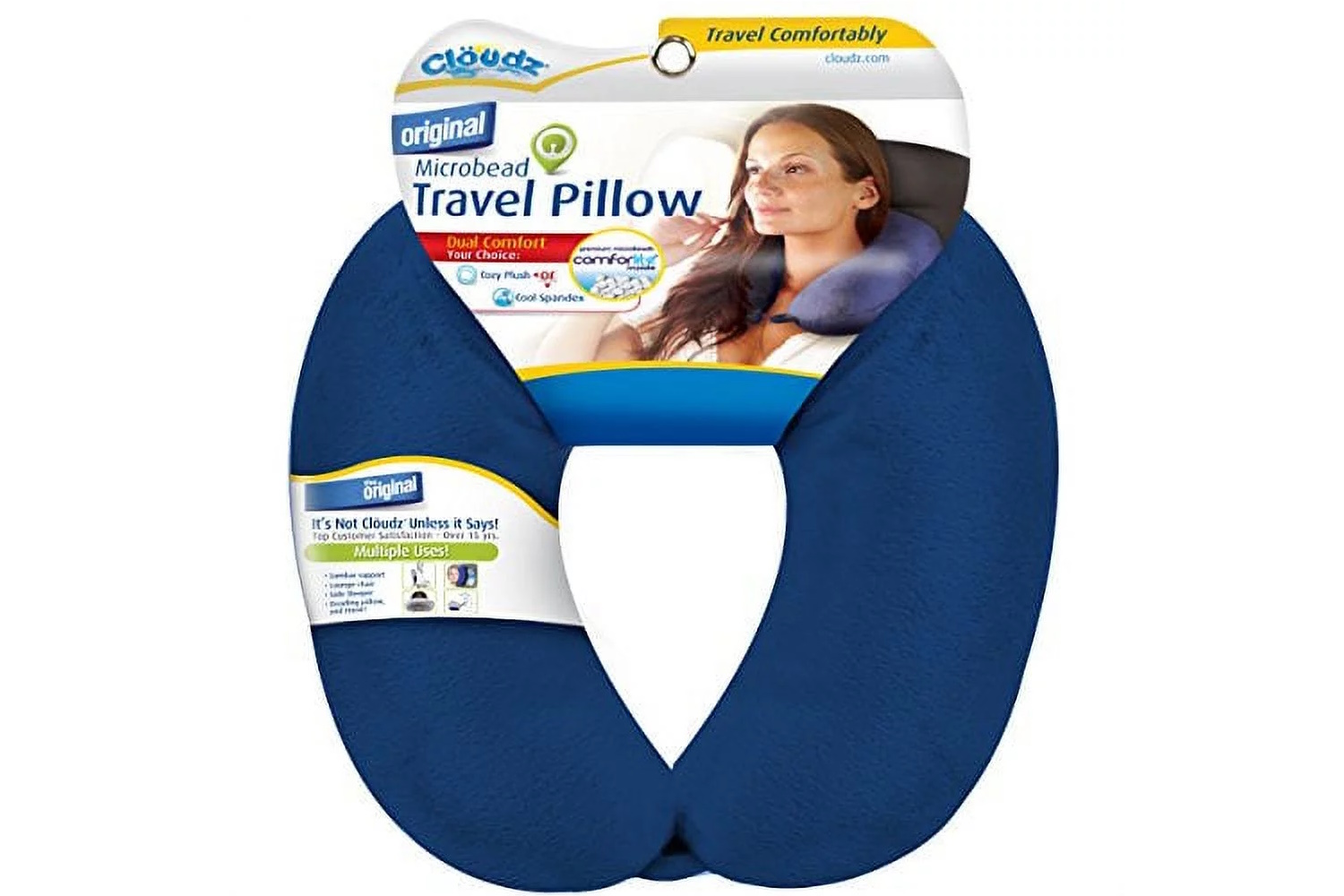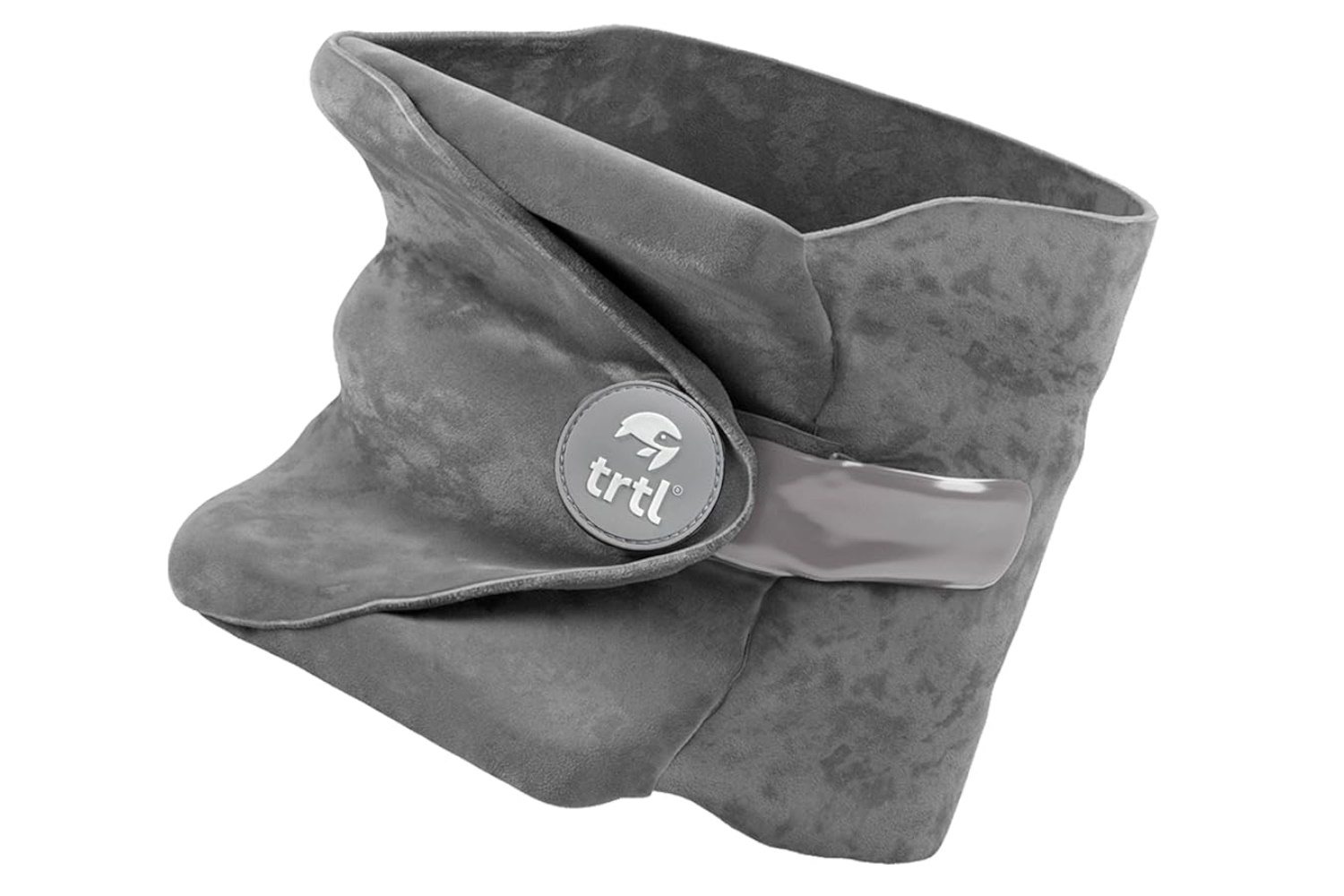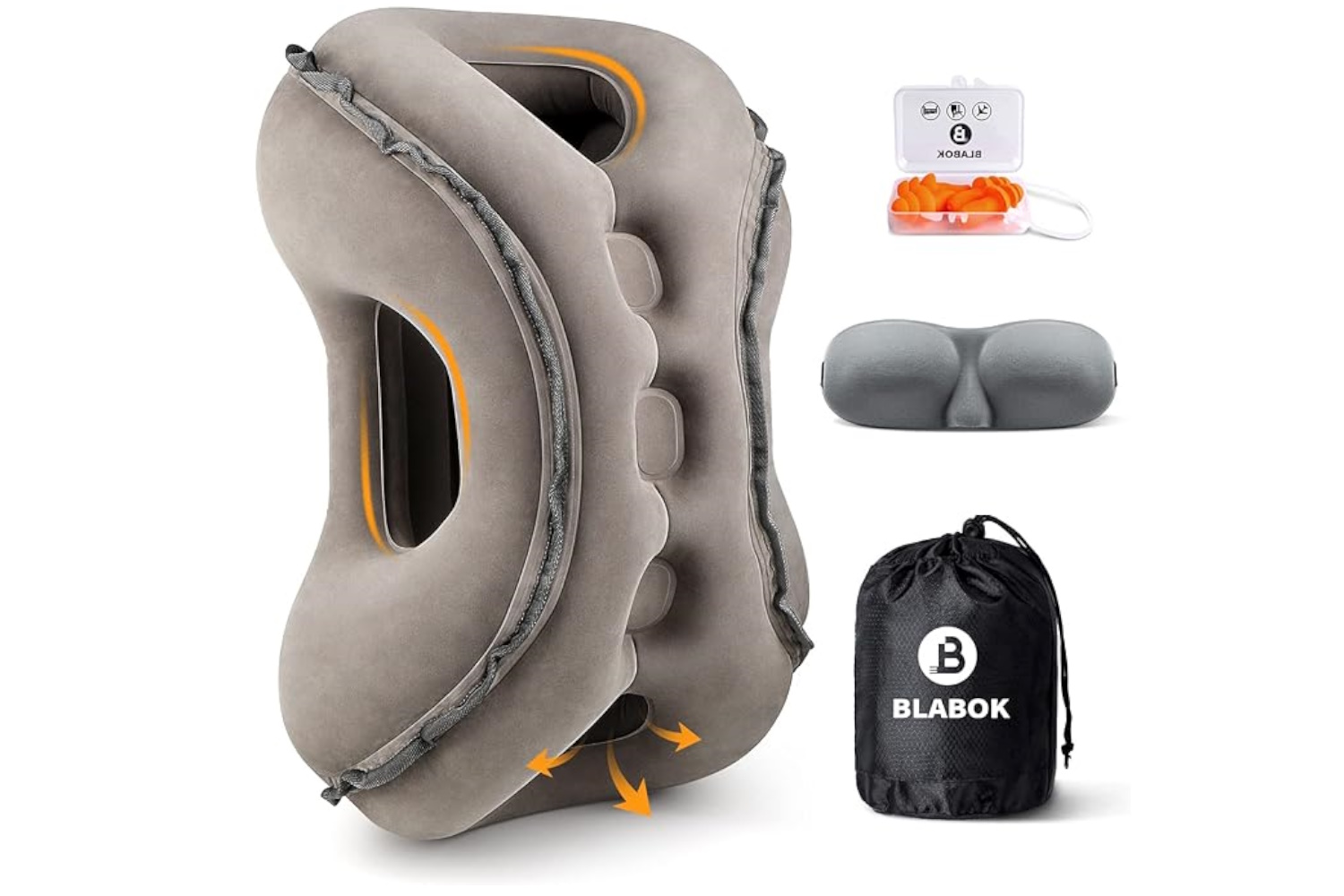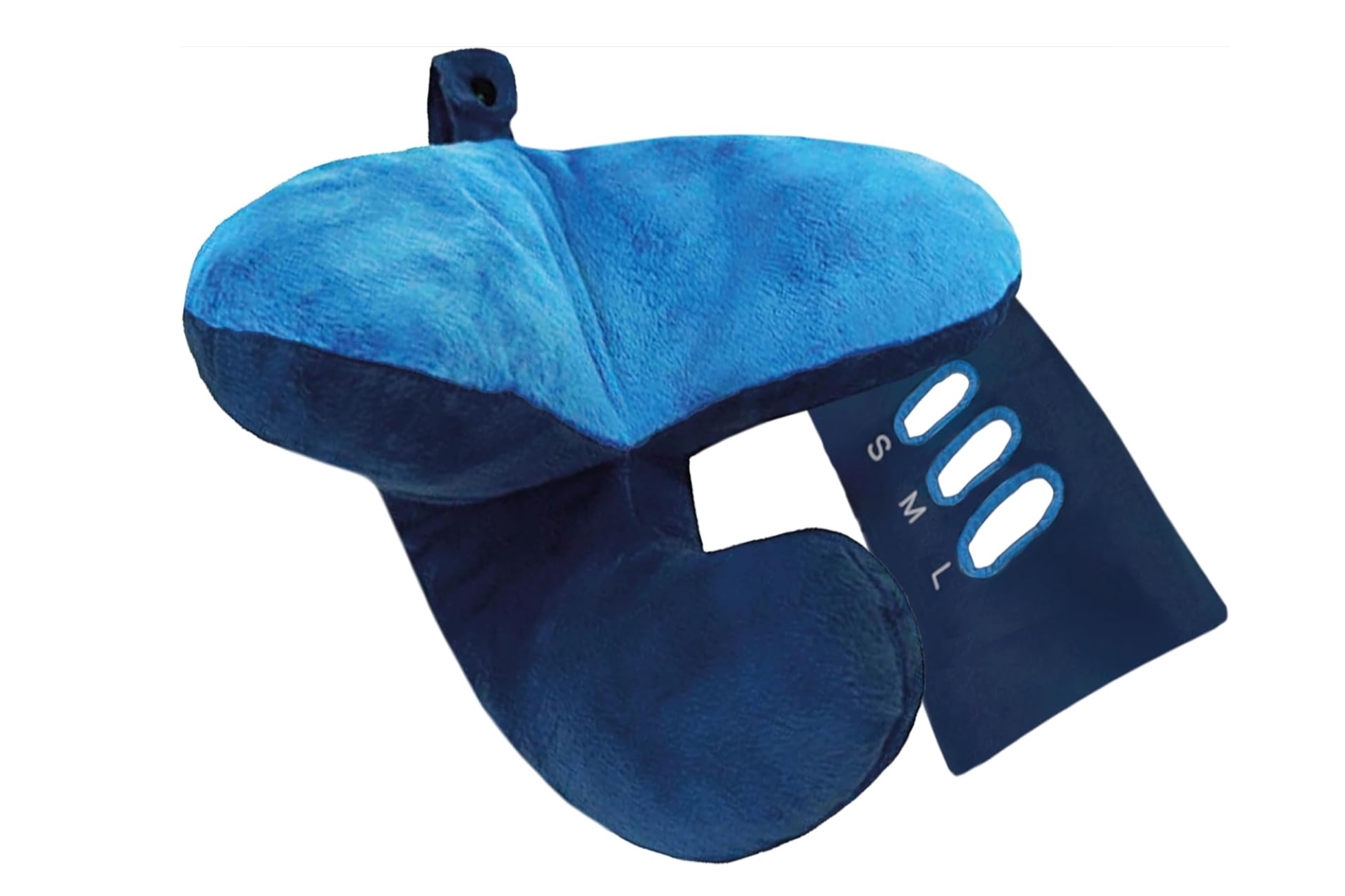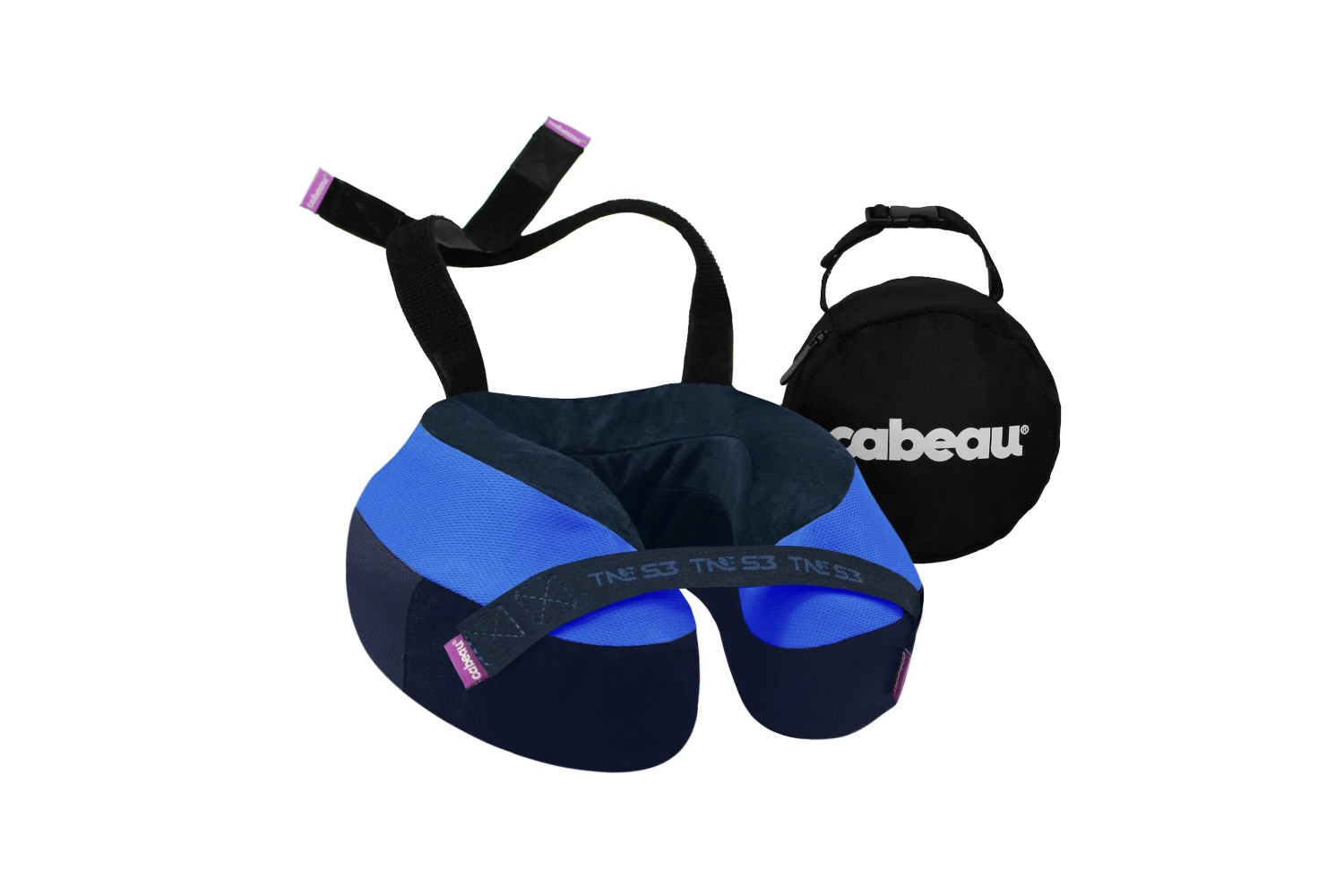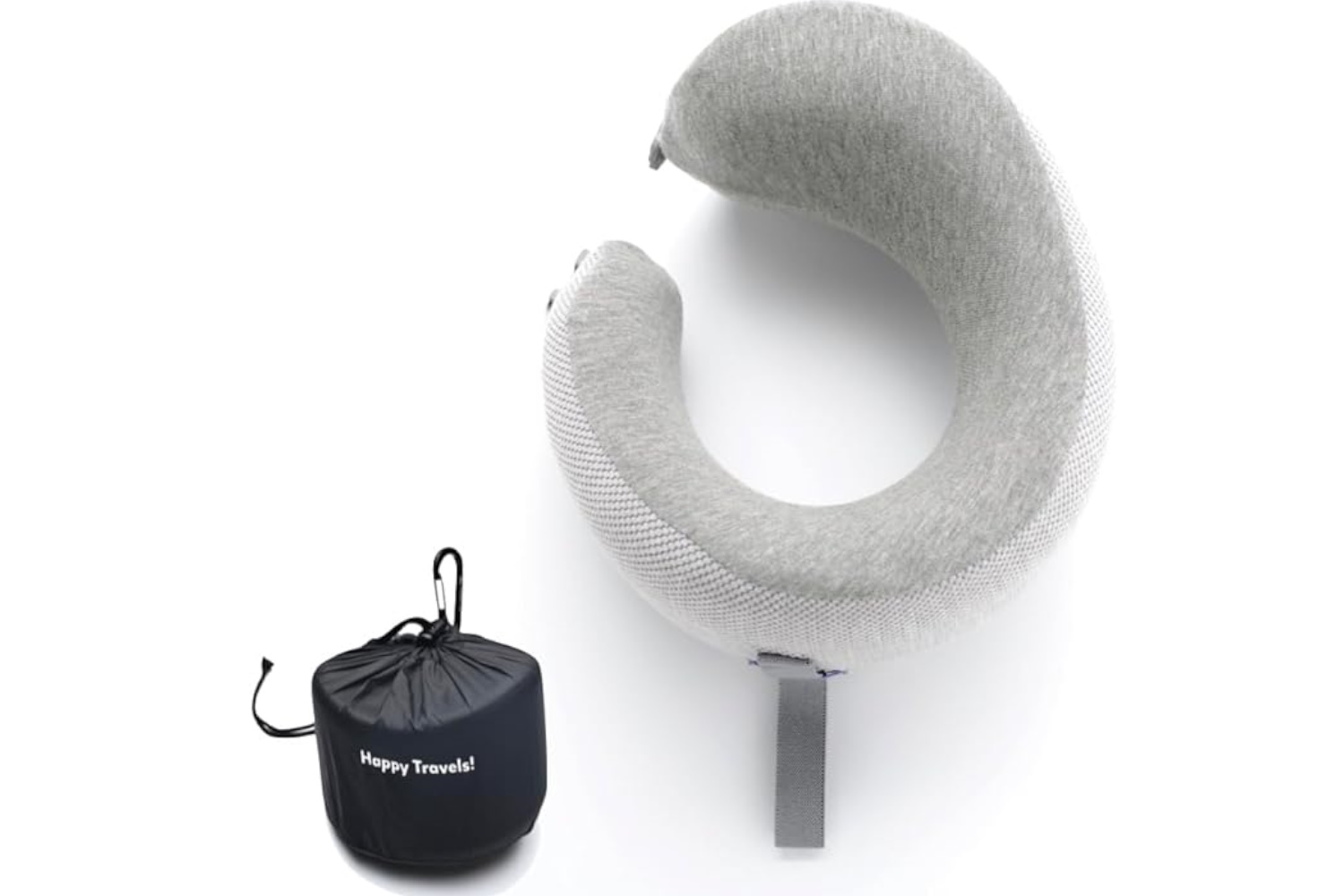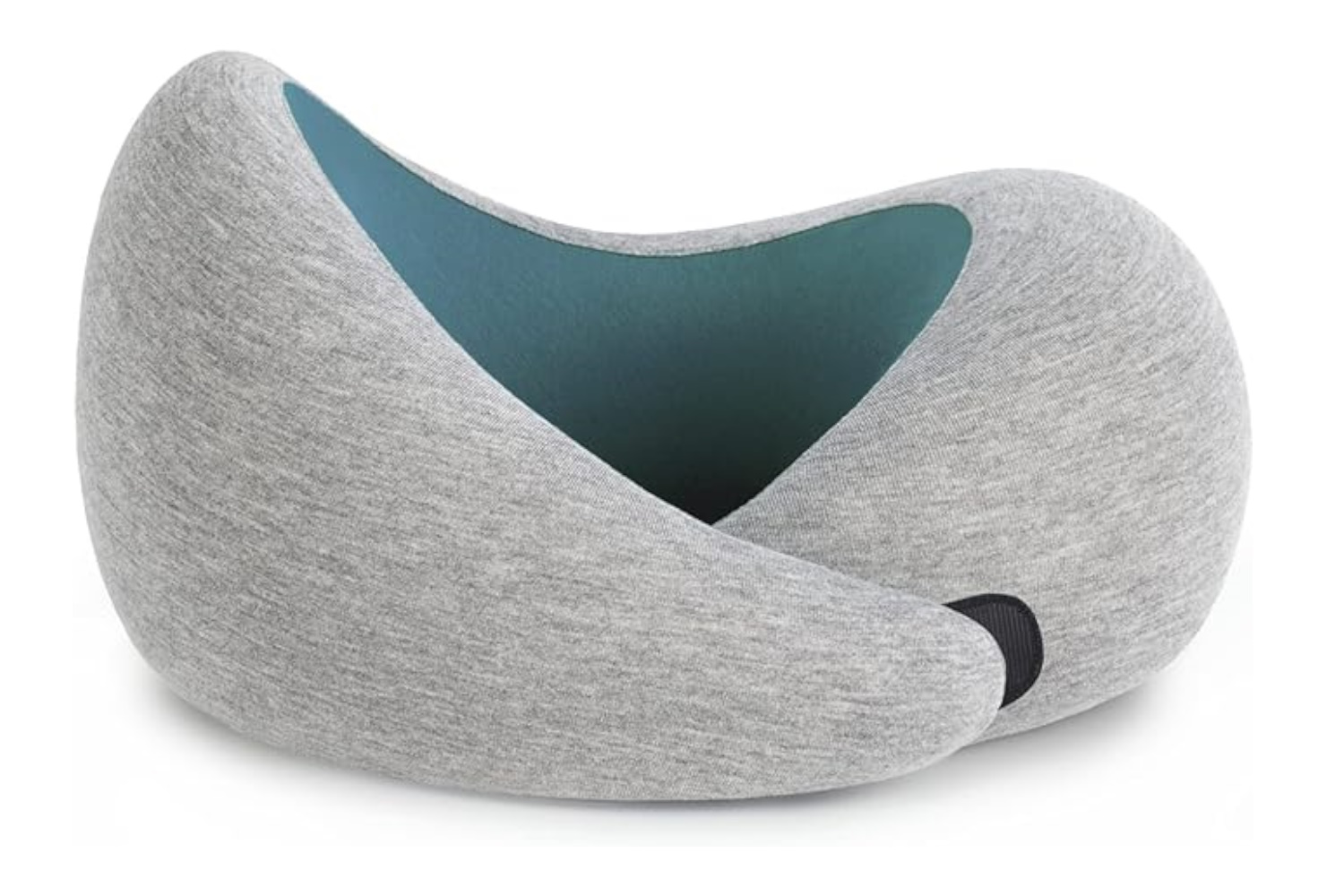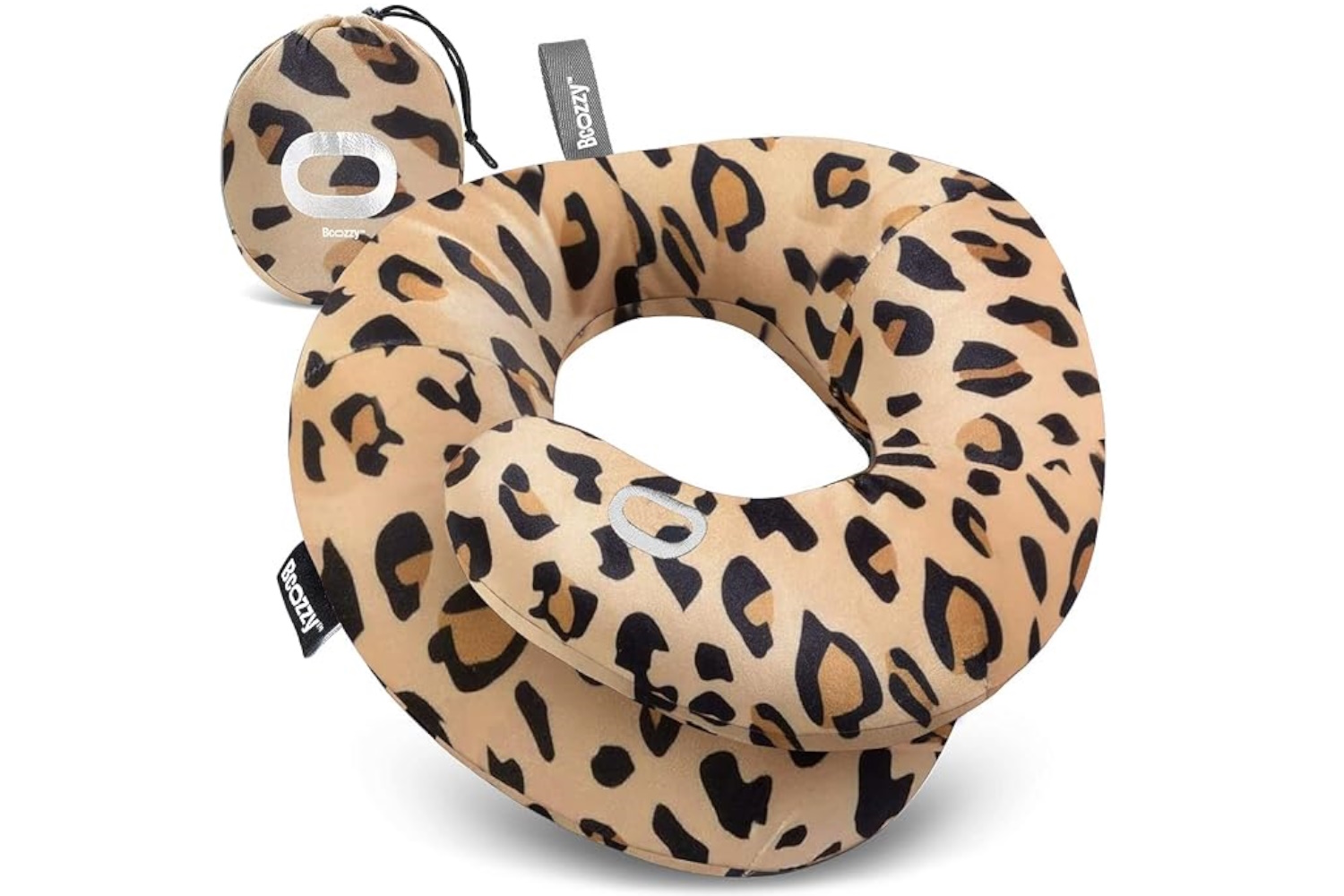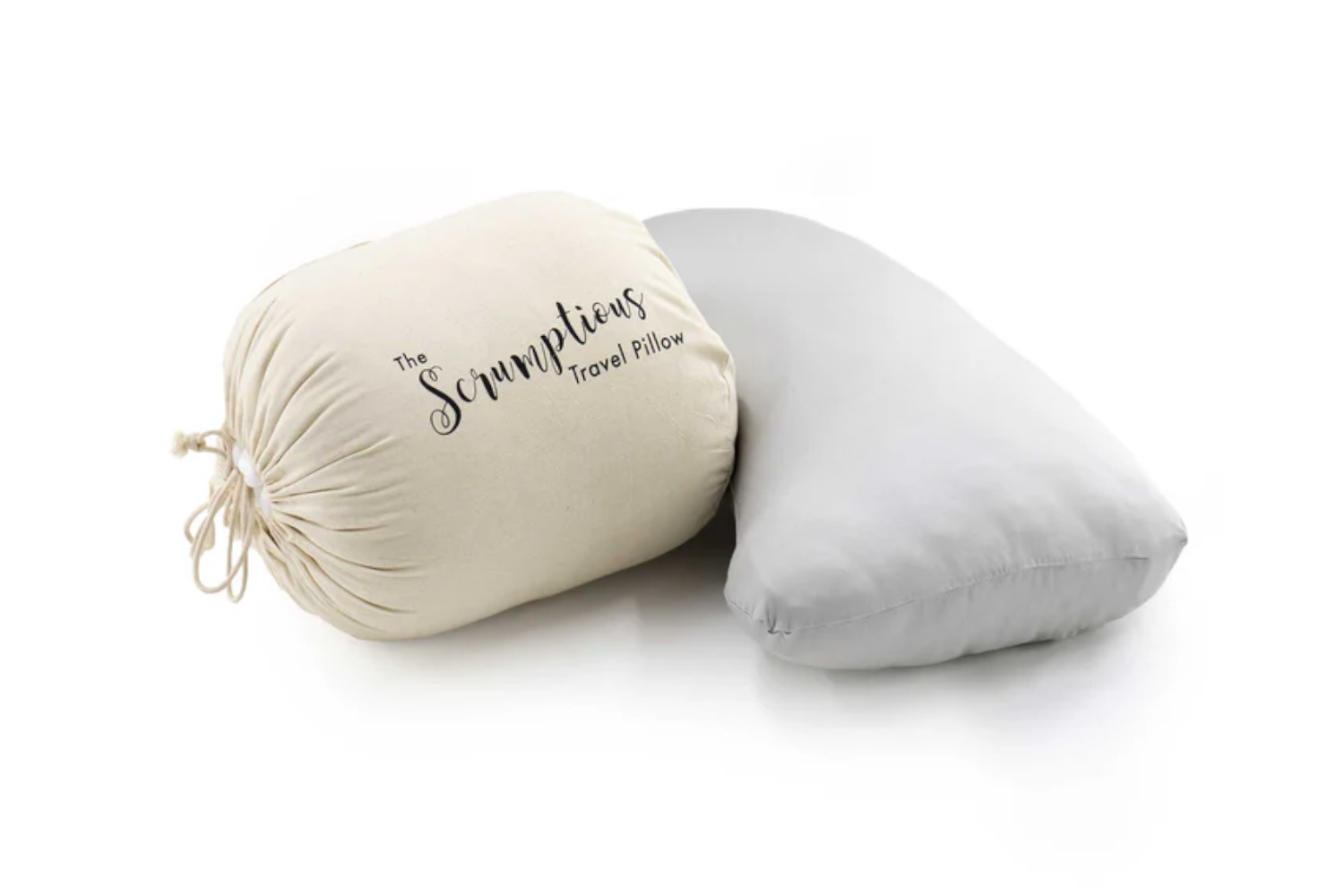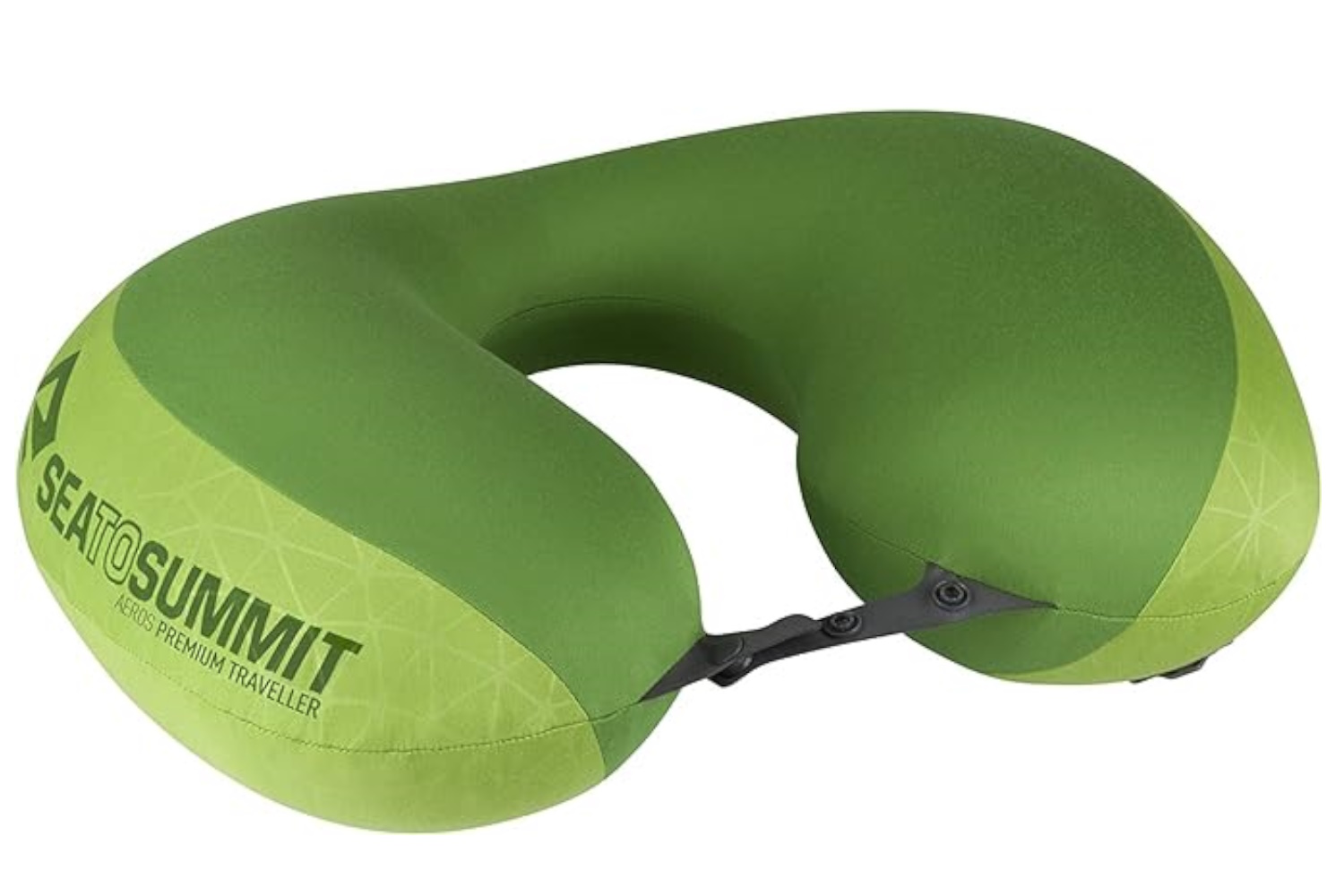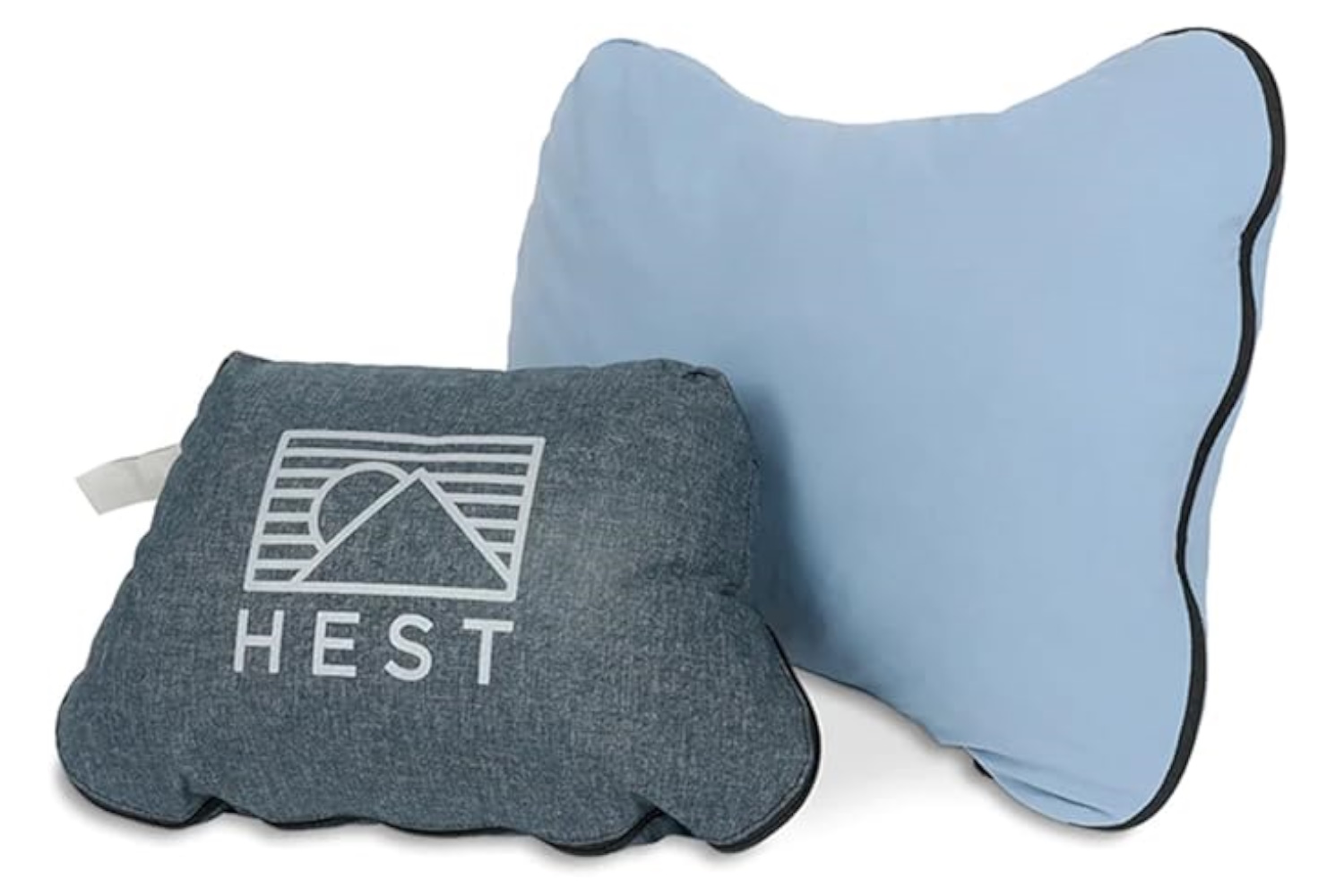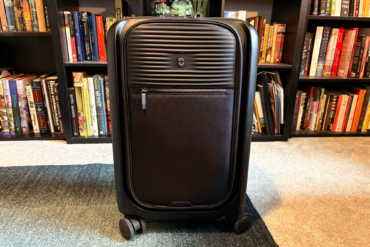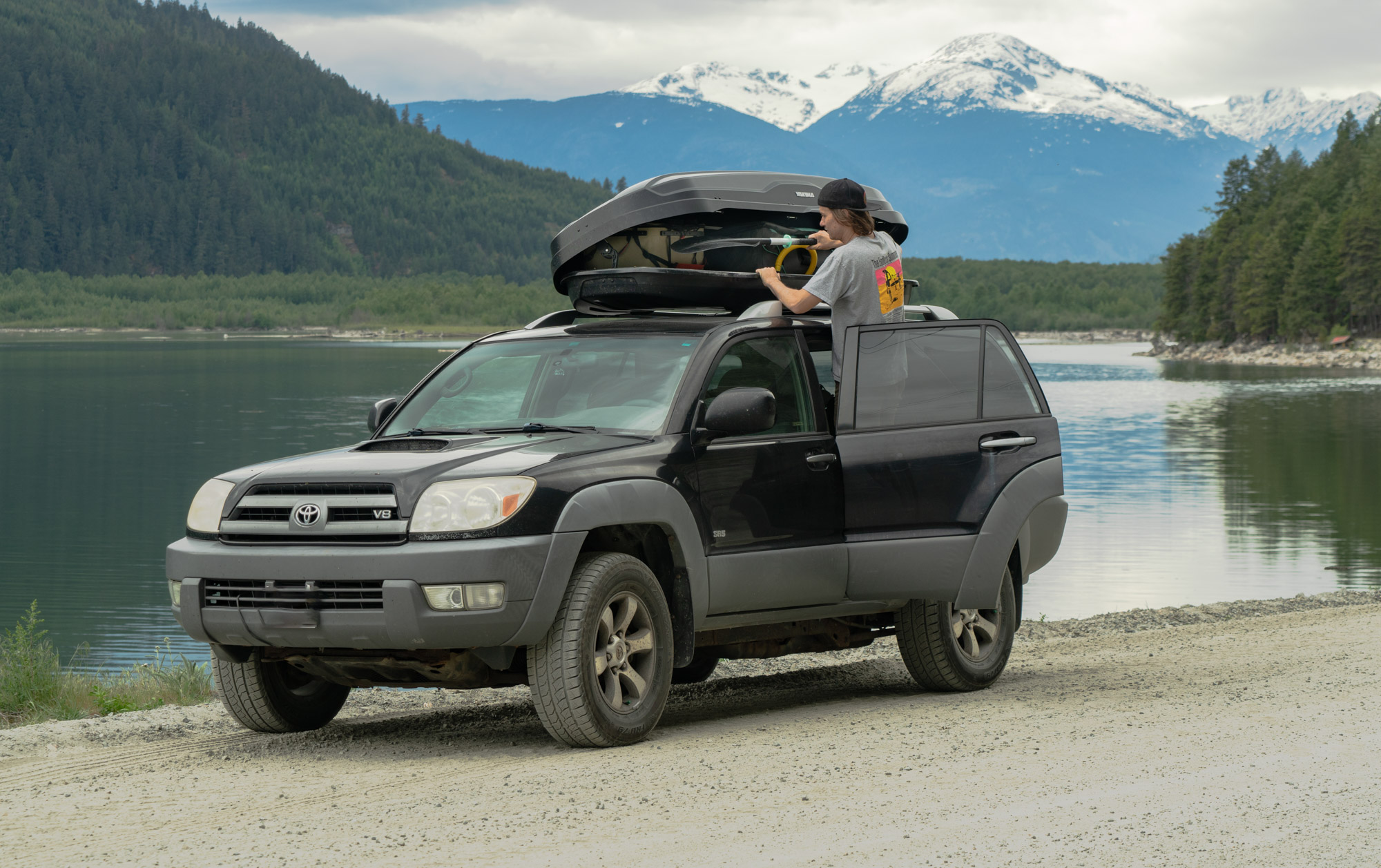Upgrade your next flight with a travel pillow. We’ve all been there: shuffling through first class, looking at the legroom, the side tables, and the seats that fully recline into flat beds. That’s why we’ve tested the best travel pillows for seasons of travel now in our search for a slice of the good life — and some well-needed shuteye.
Our expert’s travel schedules aren’t stacked — we’ll take maybe five flights a year. But arriving rested is important for a number of reasons, and along the way, we paid special mind to just how well we snoozed, how compact these pillows packed up, and how easily they traveled through the terminal.
Whether you’re after the premium sleep provided by our top pick, the Travelrest Nest, or just need a simple budget cushion like the Cloudz Microbead Travel Neck Pillow for a quick bus trip, we’ve got options for all travelers. To find the best travel pillows for 2024, we tested 20 pillows and found that every pillow on this list is a sleep number champ.
After perusing our selection, have a look at our spec Comparison Chart and read the Buyer’s Guide for more info. The Price & Value section will also give you a good idea of what you’ll get for your travel funds. Otherwise, tuck into our list of the best to catch some shuteye with.
Editor’s Note: We updated our Travel Pillows guide on November 8, 2024, to add a new Price & Value section, as well as additional comparisons between pillows that should help you make the right choice.
The Best Travel Pillows of 2025
Travelrest Nest Ultimate Memory Foam Travel Pillow
- Materials: Memory foam
- Shape: Neck pillow
- Weight: 13 oz.
- Travel Bag: Yes
Pros
- Ergonomic design aligns the back of the pillow flush with seat
- Best in class memory foam pillow is soft and supportive
- Great lateral and chin support stabilizes the head in all directions
Cons
- Some compression against the jugular when strapped down too tight
- Foam closes around the neck entirely, which can trap heat and feel too warm for some
Cloudz Microbead Travel Neck Pillow
- Materials: Microbeads
- Shape: Neck pillow
- Weight: 7 oz.
- Travel Bag: No
Pros
- Inexpensive option
- Good for side sleepers
- Dual-sided microfleece or spandex cover for temperature regulation
Cons
- Large volume behind the neck requires you to rotate the pillow to the side to sleep.
- Bulky
- No pillowcase or travel bag
Trtl Travel Pillow
- Materials: Fleece scarf with internal plastic frame
- Shape: Neck pillow
- Weight: 4.25 oz.
- Travel Bag: Yes
Pros
- Small and compact pillow
- Removable case
- Supportive for head bobbers
- Light weight
Cons
- Looks like a neck brace
- Caused some mid-back pain on longer flight
Blabok Inflatable Travel Pillow
- Materials: Vinyl with air
- Shape: Head pillow
- Weight: Unknown
- Travel Bag: Yes
Pros
- Inexpensive
- Incredibly comfortable
- Easy to inflate and deflate
- Comes with eye mask and ear plugs
Cons
- Incurs funny looks
- Space hog
J-Pillow Travel Pillow
- Materials: Polyester fill
- Shape: Head and neck pillow
- Weight: 11 oz.
- Travel Bag: Yes
Pros
- Great for side sleepers who lean against a wall
- Chin support spots you from leaning forward
- Soft microfleece cover
Cons
- Only supports one side of the head
- Doesn't compress down as well as memory foam
Cabeau The Neck’s Evolution S3 Neck Pillow
- Materials: Memory foam
- Shape: Neck pillow
- Weight: 13 oz.
- Travel Bag: Yes
Pros
- Best in class memory foam comfort
- High lateral walls for maximum head support
- Seat straps holds pillow to the chair
- Over-the-top elastic strap supports chin and keeps mouth closed
Cons
- Raised side supports feel bulky and adds pressure around the neck
- With straps, this is a more fidgety travel pillow and takes time to set up
Cushion Lab Ergonomic Travel Pillow
- Materials: Memory foam
- Shape: Neck Pillow
- Weight: 10.5 oz.
- Travel Bag: Yes
Pros
- Asymmetrical design rotates 360˚ to fit a variety of sleep positions while seated
- Accommodates over the ear headphones
- Small packed size and comes with a travel bag
- Available in two different sizes
Cons
- Low sides do not provide as much lateral support
- Snug fit can be too tight
- Materials: Memory foam
- Shape: Neck pillow
- Weight: 13 oz.
- Travel Bag: Yes
Pros
- Asymmetrical sides allow you to rotate the pillow into multiple positions to match the seating
- Crushes down small
- Washable removable cover
- Dense memory foam has excellent support
Cons
- Expensive
- High sidewalls press into ears
- Wrapping design holds heat
- Materials: Polyester fill
- Shape: Neck pillow
- Weight: 8 oz.
- Travel Bag: Yes
Pros
- Adaptive design rotates around the neck to give you support where you need it
- Allows plenty of ear room for those who wear over-the-ear headphones
- Fully machine washable
- Four different size variations available
Cons
- Takes a while to position it right
- Snug wrapping design can get hot
- Materials: Copper infused cooling memory foam
- Shape: Head pillow
- Weight: 2 lbs., 8 oz.
- Travel Bag: Yes
Pros
- Incredibly comfortable
- You can add or remove fill to match your desired firmness
- Hand-made in U.S.A.
Cons
- Expensive
- Bulky to carry
- Large size forces chin to drop even with the seat tilted all the way back
- Materials: Cut up memory foam, stretch-woven nylon cover
- Shape: Head pillow
- Weight: 1 lb., 4 oz.
- Travel Bag: Yes
Pros
- Stuffs and zips up into into itself with durable outer carrying case
- Soft and incredibly comfortable foam fill
- Mimics the feel of a full-size pillow
Cons
- Expensive
- Soft pillow case is purchased after market
- Some users find the cut up memory foam feels lumpy
Travel Pillow Comparison Chart
| Travel Pillow | Price | Shape | Materials | Travel Bag | Weight |
|---|---|---|---|---|---|
| Travelrest Nest Ultimate Memory Foam Travel Pillow | $40 | Neck pillow | Memory foam | Yes | 13 oz. |
| Cloudz Microbead Travel Neck Pillow | $16 | Neck pillow | Microbeads | No | 7 oz. |
| TRLT Travel Pillow | $60 | Neck pillow | Fleece scarf with internal plastic frame | Yes | 4.25 oz. |
| Blabok Inflatable Travel Pillow | $25 | Head pillow | Vinyl with air | Yes | Unknown |
| J-Pillow Travel Pillow | $50-60 | Head and neck pillow | Polyester fill | Yes | 11 oz. |
| Cabeau The Neck’s Evolution S3 Neck Pillow | $50 | Neck pillow | Memory foam | Yes | 13 oz. |
| Cushion Lab Ergonomic Travel Pillow | $55 | Neck Pillow | Memory foam | Yes | 10.5 oz. |
| Ostrich Go Neck Pillow | $70 | Neck pillow | Memory foam | Yes | 13 oz. |
| BCOZZY Neck Pillow | $45-60 | Neck pillow | Polyester fill | Yes | 8 oz. |
| Honeydew Scrumptious Travel Pillow | $130-220 | Head pillow | Copper infused cooling memory foam | Yes | 2 lbs., 8 oz. |
| Sea To Summit Aeros Premium Traveller Pillow | $45 | Neck pillow | 20-denier polyester face fabric, TPU air bladder | 3 x 4 x 2″ soft-sided case | 3 oz. |
| Hest Camp Pillow | $75 | Head pillow | Cut up memory foam, stretch-woven nylon cover | Yes | 1 lb., 4 oz. |
How We Tested the Best Travel Pillows
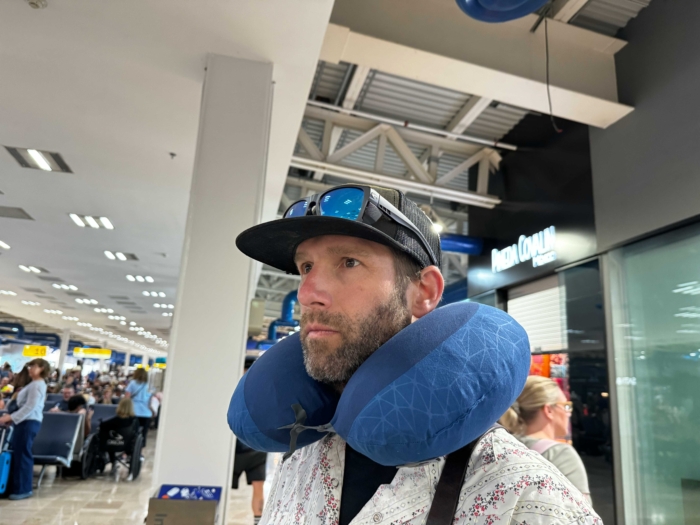
Our Expert Testers
The GearJunkie staff gets around. At least one of us is in the air during any given week traveling on assignment — so we’ve logged the miles, all of them in coach, and many of these clocked across the Atlantic or Pacific. The redeye may be effective, but it also means if we don’t get our rest, we are up for a very long following day. To make it all work, the GearJunkie staff gets by on coffee… and travel pillows.
Steve Graepel has worked at GearJunkie as a contributing editor since 2009, testing everything from packrafts, to bike bags, cycling bibs, sleeping bags, winter boots, trail runners, and travel pants. Many of these stories require travel to meet with manufacturers and test gear in real-world conditions. Between testing, Steve is always striving for the perfect sleep score. His personal best is 87.
Our Testing Grounds
Sometimes we splurge on the good seats on long-haul flights, but more likely than not, we’re in the cheap seats during air travel, exactly where some added comfort like a travel pillow is key. We’ve racked up the air miles in testing these pillows, traveling to Mexico, Iceland, and even farther afield still, spending hours in coach with these options.
Our travel testing isn’t limited to just airline travel, however. We’ve been stacked into long-haul buses across the high deserts of Patagonia, taken trains across Western states, and while we’re not quite the type for cruises, we’ve taken a few ferry rides in our day. All of these modes of transport offer up a different experience and require something different to try and get some shuteye.
Our Testing Process
Like your pillow at home, a travel pillow should support the neck and be comfortable. Since it’s for use on the road, it should also pack up small so we can either wear it to our connecting flight or securely clip it to our carry-on luggage or travel backpack without whacking other travelers.
To test pillows, we evaluated fill materials and took note of how pillows supported the neck. Did it limit head bobble and keep the neck aligned? Or were we woken up nodding forward? We evaluated how soft the outer material is and if we could remove and wash the case during or after our travels.
In our search, we aimed to find and test pillows that every person stuck in coach across the spectrum could enjoy — from window, aisle, to middle seat (be damned), we chose for travelers marching gate to gate with pillows around necks or strapped to our luggage.
We take testing seriously, and the testing doesn’t stop here. As new travel pillows hit the market, we’ll be lining up with the rest of you and continue to test, ensuring that our lineup is as fresh as walking into customs at 7 a.m.
Buyer’s Guide: How to Choose the Best Travel Pillow for You
Travel Pillow Design and Fill
The overall goal of a travel pillow is to support the head for uninterrupted rest. Travel pillows get this done with designs that contour around the body’s shape and close the gaps by molding the pillow’s fill to the head and neck. Together, the shape and fill keep everything comfortably in alignment.
Design
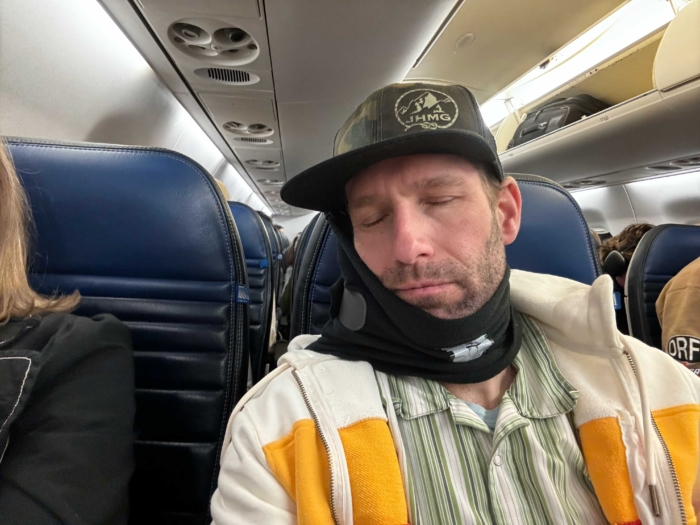
Not all pillows are created equal. That’s because not all seats are the same. While you can lean your head against the wall in a window seat, you are stuck sleeping upright in an aisle or middle seat. Bobblehead sleepers might give in and drop into the tray for uninterrupted sleep.
If you can select your seat in advance, you can better predict the best pillow to bring. But we’re not always that lucky (nor that good at planning), so it might be helpful to have a few pillows available to match your assigned seat, or pick a good all-rounder travel pillow that works in a variety of seating.
Most travel pillows are horseshoe-shaped and wrap around your neck. The semicircular shape keeps the head from wobbling too much and maintains neck alignment. This design works well in almost every seat, as long as you don’t mind sleeping upright.
Side sleepers might prefer some structure to support the neck or padding that accommodates leaning against a wall. The downside is your head can still slide off the unsupported side and nod forward.
The rectangular pillow is your traditional camp pillow. Tried and true, these down, synthetic, or even air-filled pillows can be a little bulky, but don’t rule them out. They are a great option for table sleepers and window leaners, and are miles ahead of your down jacket when trying to catch some zzz’s between flights on the terminal floor.
A more updated window seat option is the J-Pillow. Winner of the British Invention of the Year, the J-Pillow offers head, neck, and chin support, and can flip sides, making it a good option for windows.
Memory Foam
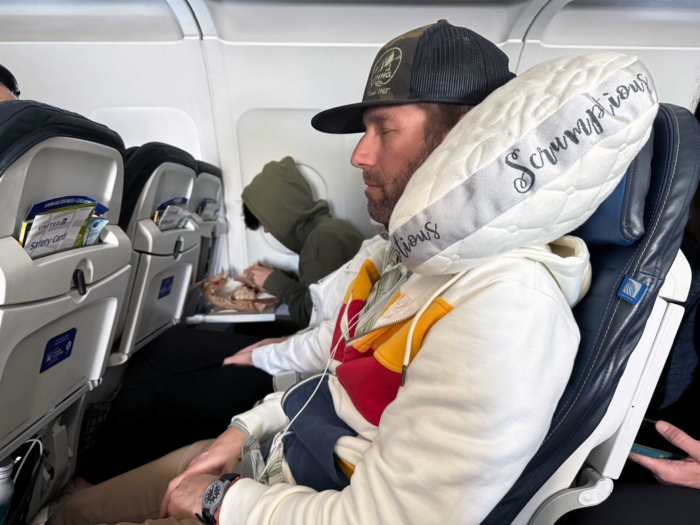
One of the many wonders that came out of NASA, memory foam was developed in the 1960s. It is a viscous polyurethane that crushes down small and bounces back with hearty resilience. Recently, memory foam has become the online mattress wonder-kid, bringing mattress stores to their knees by selling directly to consumers.
We also see a lot of memory foam used in the latest camp mattresses and camp pillows. The benefit is that it forms to the body, cradling the head and neck with support. It’s a durable and comfortable fill and is a good choice for people who take sleeping seriously.
The downside is that when crushed, the foam is constantly trying to expand. To keep the pillow packed down, you need to stuff it in the stuff sack (usually sold with the pillow). And even packed, it’s always going to take up some space. A good insulator, foam will also retain heat more than other insulations. If you are a hot sleeper, consider options with cooling covers and venting designs.
Some memory foams are shredded or cut into small pieces. The foam lofts evenly but doesn’t crush down as small as the solid memory foam pillows. Both Hest and Honeydew offer shredded memory foam pillows. Both brands are also traditional rectangular-shaped pillows that mimic your pillow from home.
Microbeads
As the name implies, microbeads are small, round beads that are used to loft the pillow. To clarify, we aren’t talking about the microspheres smaller than one millimeter that are banned in North America. These are the larger, beanbag fill that shift inside the pillow to fill in otherwise awkward spaces while distributing pressure on the head and neck.
If you’ve ever spent much time sitting in a bean bag chair, you already know the downside. A microbead pillow can be comfortable out of the gate, but over time, the microbeads shift and feel more uncomfortable. You might find yourself waking up and readjusting the pillow during your flight.
A firmer, stuffed microbead pillow will provide more support, and microbead pillows are usually less expensive. The only microbead pillow on our list is the Cloudz Microbead Travel Neck Pillow. At $16, it’s a bargain and works better than other microbead pillows we’ve tested.
Down and Synthetic Fill
The rectangular synthetic (or down) fill pillow is your old-school camp pillow. While down compacts more, both synthetic and down rectangular pillows can be a little bulky, and since they typically don’t clip to your luggage or wrap around your neck, you inevitably need to carry them around in your hands.
But don’t rule them out — they are a great option for table sleepers, as they fill in the gaps against the window, and are miles ahead of your down jacket when trying to catch some zzz’s between flights on the terminal floor. Plus, you can use them camping or at the hotel if the provided linens look debatable.
Inflated Air
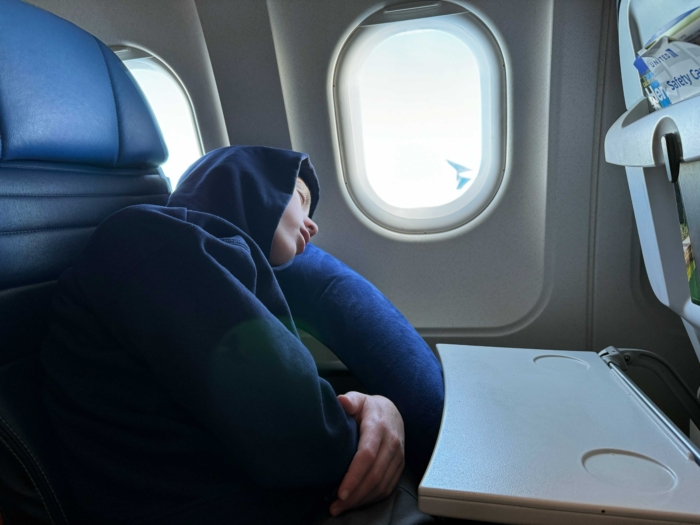
Pillows have come a long way, but some technology doesn’t need to be fixed. The inflatable pillow supports through design of the shell that wraps around the neck. An inflatable camp pillow is great for use on extended backcountry trips. They pack down small and disappear in the pack.
In general, inflatable pillows aren’t as comfortable. They tend to be firmer than foam pillows and don’t snug and support as well as their memory foam counterparts. And they can be prone to punctures, which makes them useless if that happens in flight.
Look for inflatable pillows that are made up of durable material, like thermoplastic polyurethane (TPU), or one that comes with a rugged cover. Valves can also be a weak point on an inflatable pillow. Make sure the one you buy has a tough, well-built valve that isn’t prone to leaking. And ask around — fellow travelers and online reviews are your best resources for gauging a pillow’s durability over time.
All said, we found the inflatable travel pillow from Blablok one of the most comfortable pillows we’ve ever used. It’s massive but compresses down to a small package — one of the benefits of inflatable pillows.
Durability
With a travel pillow, a huge part of durability is inside the pillow. With proper care, a pillow filled with either microbeads, polyester fill, or memory foam can last for several years.
However, after repeated use, memory foam tends to be more durable and resilient than microbeads. It doesn’t flatten or get lumpy and is more resistant to collecting dust. So memory foam might be the better option if you want a long-term solution. We generally find memory foam to be more supportive, too.
Packed Size
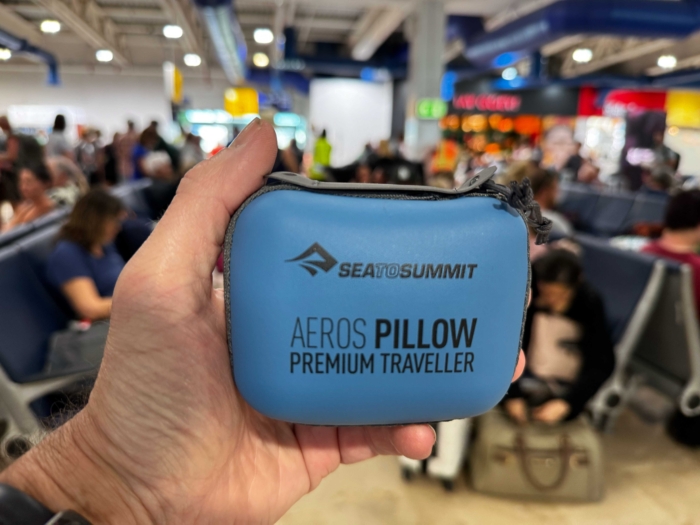
The ‘packability’ of a travel pillow matters less than it does for a camping pillow. But it still matters, and this point will be salient when you are boarding and departing the plane. If it wraps around your neck, you can suck it up and try to stylishly pull it off (don’t worry, nobody can). If it has a stuff sack, you can compress it (or not) and buckle it to your luggage. As a last resort, you can carry it out by hand.
We recommend stuffing a travel pillow in its stuff sack before you land and snapping it to your carry-on’s side pocket. This keeps the pillow out of the way and allows you to move quickly in and out of the gate and through the terminal.
The most compact travel pillow is an inflatable pillow, like the Sea To Summit Aeros Premium Traveller Pillow. In general, we prefer a compressible pillow that offers support. Memory foam compresses reasonably well and, in our experience, is more comfortable.
Plus, we’d rather not make our first impression with others by blowing up anything on a plane. That said, the inflatable travel pillow from Blablok inflates quicker than you would think and is very comfortable on long flights.
Travel Tricks: Get a Good Night’s Sleep on a Plane
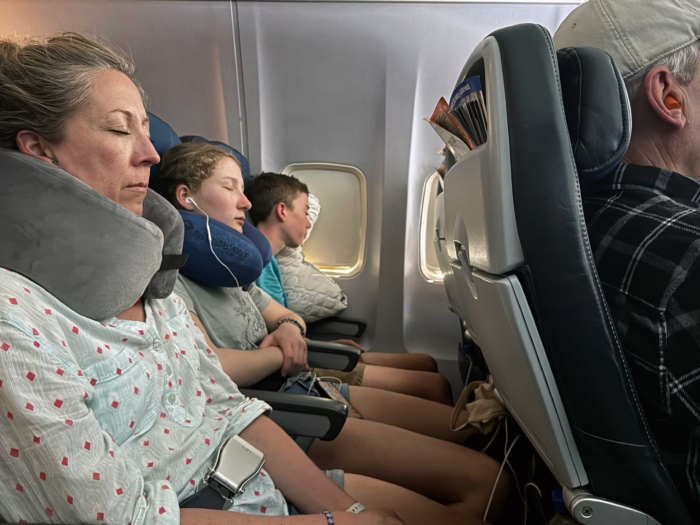
It’s fair to say sleep quality is compromised while in transit. But you can take extra measures to get the best rest possible. Below are travel tips we’ve gained from GearJunkie staff and our traveling friends in the industry.
Bring an Eye Mask
Sure, you can buy these, but you may not need to. We always travel with a Buff. Our founder, Stephen Regenold — someone who’s seen it all — gave the Buff one of his highest accolades in a podcast interview with GearJunkie. He shared that the Buff might be one of the most unique pieces of gear ever developed. We use it as a hat, a sweatband, and pull over the eyes on flights. It does a great job of blocking out the light.
Ear Plugs
Continuing with damping out the senses, earplugs are a cheap and easy purchase. We get them in bulk at the hardware store and bring a few with us on the road. You may have a pair of these kicking around the garage, or you might have noise-canceling headphones. Those less sensitive to sounds might get away with streaming music or podcasts through earbuds.
If you use over-the-ear headphones, consider a lower-profile travel pillow. We liked how the Bcozzy Travel Pillow slides low around the neck while still providing chin support options.
Stay Warm
The cabin temperature on flights is generally set between 71 to 75 degrees F. That’s not bad, but it’s well below our core temperature. Dozing off, you may start to feel the chill set in. We always pack a good flannel, hoodie, or puffy jacket on a flight. It’s what we bring everywhere, so we keep one (or both) in our carry-on. And a hoodie or hat does a lot to keep heat from escaping.
Before you bed down, have a warm cup of caffeine-free tea or eat some fatty food. The extra calories will turn on your metabolism and burn off as heat. Finally, if they offer it, take advantage of that free blanket and drape it over your legs. If you run cold, every little bit helps.
Keep the Essentials at Hand
There’s a strategy for staying organized during travel. For us, it starts with a good travel pant. Knowing everything has its place keeps us worry-free and able to rest up peacefully. The best travel pants have pockets for your device, ID, and plane-friendly EDC. Plus, pants with legs are warmer on overnight flights.
Price & Value
In general, the more features a pillow has, the higher the price will be. We see this with well-established companies like Cabeau, which use high-quality memory foam and invest time in R&D to develop cooling vents and stabilization seat straps. While more expensive, these products are more dialed, durable, and comfortable designs.
When you shop for a pillow, determine your must-have features, weigh them against your style of sleep, look at your budget, and find a travel pillow that’s best for you. If you’re new to travel pillows and still trying to figure out what kind of pillow you want, consider what you don’t like with the complimentary pillow you get before takeoff. After all, it’s free and a great way to test a pillow with low commitment.
With that baseline, swing back by our buyer’s guide and look at what pillows work best to meet those gaps in your needs. In the end, a travel pillow shouldn’t cost more than $60. It’s a drop in the bucket for a better travel experience.
Budget
Budget travel pillows are ideal for short train or bus trips, where the prospect of solid sleep is low, but you may as well be comfortable for the ride. The $16 Cloudz Microbead Travel Neck Pillow doesn’t ask much, but it provides good enough support that should allow for your napping. The microbead fill is typical of budget pillows and isn’t quite as supportive as higher-end fills like memory foam.
Mid-Tier
Spending a bit more will get you a more versatile travel pillow, such as the Travelrest Nest ($40), a memory-foam-filled traditional neck cradle that will allow you to get some quality sleep on a redeye flight. Paying a bit more here gets you more 3D contouring in the pillow shape, and the extra support is well appreciated. For a bit more still, you can get a more specialized pillow, and the TRLT Travel Pillow ($60) is ideal for the needs of side sleepers.
Premium
$70+ travel pillows will have the nicest materials out there, from memory foam fills to stretch-woven microfiber shells. They also will be useful beyond the flight, and we found the Honeydew Scrumptious Travel Pillow ($130-220) worked just as well at the hotel as it did in the air. The price is hefty, but dual-use items can make it worth it.
Frequently Asked Questions
Absolutely. Travel pillows add a bit of comfort and help you get a better night’s sleep on the plane than a wadded-up jacket. The minimal investment of money, space, and weight is nothing compared to the comfort and support a good pillow provides. It only takes one long flight of trying to keep your head upright while dozing off to realize the value that a good travel pillow provides.
Different pillows have different requirements when it comes to cleaning. Be sure to check your pillow’s packaging. If your travel pillow has a removable pillow case, generally these can be thrown in the wash. We recommend following the instructions on the pillow case.
If you are on the road, you can wash the pillow cover out in the sink. You don’t need any special soap for this. Laundry soap or bath soap will work fine. Knead the pillow case gently with your hands until it’s clean. Then rinse it with clean water to get the soap out and hang it out overnight to dry.
If your pillow doesn’t have a removable case, we recommend spot washing them with soap and water or a cleaning wipe.
Most pillows require a bit more delicacy, particularly inflatable pillows. If you’re handwashing an inflatable pillow, make sure the valve is closed so water doesn’t get inside, and then immerse the pillow in soapy water. And never tumble-dry inflatable pillows, as it can damage the air bladder.
The best pillow is the one that matches your sleep needs. Most travel pillows are a horse-shoe shape that wraps around your neck to support your head. If you only want to buy one travel pillow, this semicircular pillow design is a great option. We recommend the Travelrest Nest Travel Pillow. It supports the head and neck without requiring a window to lean against and keeps you from nodding into an adjacent stranger.
Specialized pillows, like the J-Pillow, are great options for window seats. Side sleepers might appreciate the TRLT Travel Pillow, as it supports the head with a stiffened brace and emulates the position you’re most used to sleeping in at home.
If you already have one, don’t rule out the traditional camp pillow. Filled with down or synthetic loft, it can fill the crack against the window and provide a little more comfort than the stock pillows you might be handed before takeoff. It’s also a good pillow to pull out in the terminal if you are stuck between flights and need to crash for a few hours.
Long flights mean lots of idle time in the seat. Whether passing the time watching in-flight entertainment or getting the best sleep you can, we prefer the inflatable Blablok or the Travelrest Nest. Cabeau’s The Neck’s Evolution S3 Neck Pillow is also a great choice. The straps lock it to the headrest and prevent your head from bobbling forward.
We liked the simplicity of the TRLT Pillow and used it on a flight to Mexico. But we found that the internal support structure moved any pain from the neck, down the back between our shoulders. In the end, we preferred using the TRLT on shorter flights.
The simplest and most compact travel pillow is inflated with air. It won’t be as supportive as a memory foam pillow and can feel a little hard, but the air chamber can fit around your neck and add reasonable support. Deflated, it folds up and stows away smaller than a T-shirt.
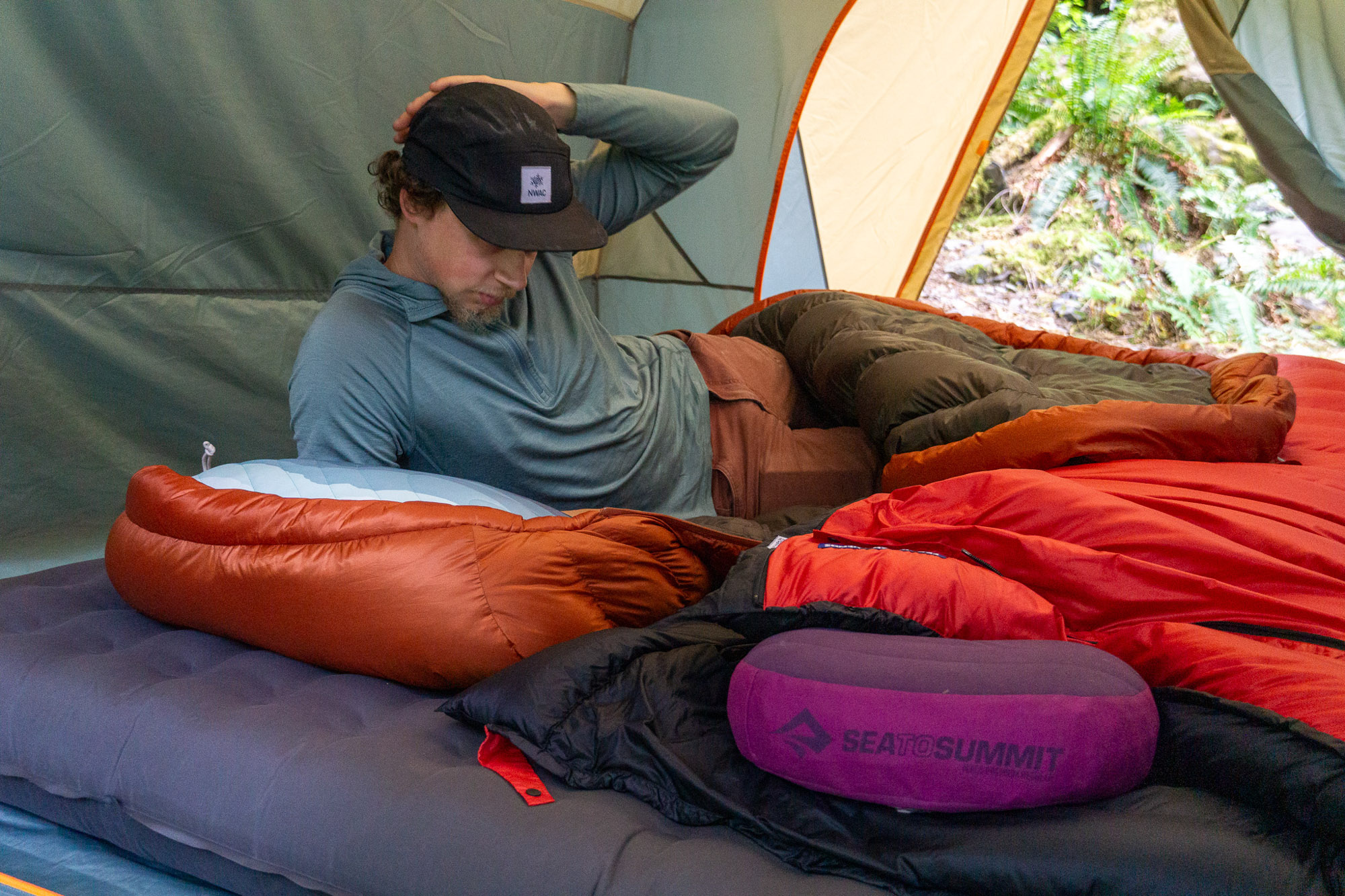
The Best Camping Pillows of 2026
A camping pillow is both a luxury and an easy, lightweight addition to your pack. Here are the best camping pillows currently on the market.

The Best Travel Backpacks of 2025
We found the best travel backpacks of 2024, including top picks from Peak Design, Osprey, Patagonia, and more.
